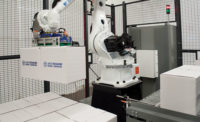Cover Story: Robotics & Automation
Sophisticated robotics reveals new technology and controls to increase efficiencies


Yaskawa Motoman’s MPP3H touts a deep work envelope and zero footprint.

PIVT utilizes technologies to detect seal contamination, leaks and pinholes that lead to the loss of package integrity.

With the RobotWare 6 upgrade, installation time is shorter and restarts are quicker.

From SIDEBAR 1: ProAdjust®

From SIDEBAR 1: Matrox Imaging

From SIDEBAR 1: FANUC America Corporation

From SIDEBAR 3: For more than two decades, robotic palletizing solutions have been advancing high-SKU, low-speed operations across the globe.








Today’s packaging robots are even more sophisticated than in previous years. The new designs, features and technology behind these systems help to increase speed and throughput and work to decrease downtime. The segment is growing (both in market saturation and sophistication) as packagers see more and more value in robots. Packagers consider robots for a variety of reasons to streamline packaging processes.
“Speed and flexibility are playing a larger role in that packagers are faced with producing a greater number of package designs at faster production rates to meet consumer demand,” says Dean Elkins, senior general manager, Yaskawa Motoman.
Speed, flexibility and productivity, oh my!
A new delta-style robot is now on the scene touting its zero footprint, deep work envelope and high payload capacity of 3kg. The MPP3H is Yaskawa Motoman’s (motoman.com) new delta-style robot for packaging, cartoning and kitting applications. The MPP3H robot features a parallel link arm configuration with a direct-driven rotary axis to simplify design and increase reliability. With a minimum installation area and zero footprint, this model is ideal for high-density installations, while providing a large working envelope (up to 600mm).
The MPP3H has several key features to simplify installation. A large 80mm thru-hole at the base allows end-of-arm tool cables to be routed through the center of the robot, permitting less complex cabling and reduced cable lengths. The thru-hole can also be used to mount the valve pack at the base of the robot, reducing the payload the robot has to carry. Also, for easier maintenance, the robot has one entry point at the base to apply lubricant.
For increased productivity and package integrity, JLS Automation (jlsautomation.com) has launched its latest subset of PIVT™ (Package Integrity Validation Technologies) system. This collection of technologies utilizes vacuum, vision and other sensor technologies to detect seal contamination, leaks and pinholes in packaging. The particular technology or technologies implemented is highly dependent on the nature of the package. For example, PIVT, when paired with a JLS’ Osprey robotic case packer, can detect leaks at high speeds and is ideal for packages that contain a brine or juice such as hot dogs and sliced luncheon meats. This enabling technology allows a robot to identify a leaky package, at line speeds of up to 160 packages per minute, and reject it. A major benefit to this is increased ROI as a result of increased productivity, labor savings and the ability to get more salable packages out the door in a shorter period.
“PIVT is a game changer,” states Craig Souser, president/CEO. “High-speed leak detection has typically been a challenge on an automated case packing system. With the first installation of PIVT on an Osprey case packer, our customer has already gained a 30% increase in productivity with a 67% reduction in packaging line labor.”
Always in control
The global motion control market is on the rise. According to new statistics released by the Motion Control Association (MCA), the industry’s trade group, global shipments for motion control products grew 9% to $2.3 billion in the first nine months of 2014.
“We’ve seen growth in each statistical category year to date,” says Alex Shikany, MCA director of market analysis. “Through September, the strongest growth has been in the AC Motors category, at 59%. Sales of motion controllers have continued to rise and are up 36% over the same period last year.”
Individually, the third quarter of 2014 followed a good first half with 14% growth to $794 million. MCA reports that the main growth categories for the third quarter were AC motors (101%), motion controllers (35%) and actuators/mechanical systems (20%).
New control products offer solutions and advancements for packaging robots, and that could explain the growth in the segment. Doug Burns, director, business development at Lenze Americas weighed in on some of these advancements for robotics in terms of motion control systems.
“Integrating robotic control with machine automation can improve system performance while simplifying programming. Having one language to program machine sequencing and robotic motion can reduce programming time by up to 80%,” says Burns.
“New tools are available that dramatically reduce development time. With standard robotic kinematics, customers can program directly, saving engineering. This allows customers to focus on making their machines better, while not having to learn a new programming language,” continues Burns.
One such new tool comes from Lenze (lenze.com), who just recently announced standardized and reusable robotics software modules as a supplement to its FAST application toolbox for automation and control designs. Using the complete robotic modules from Lenze FAST, mechanical engineers can quickly integrate kinematics into machines tailored to specific material handling tasks.
The new robotics software modules make it easy to integrate robots into an overall automation system and control them accordingly during operation of equipment. The geometric calculation of the robot, the kinematic model, is integrated with a universal method of coordinate transformation developed by Lenze in partnership with universities. The integrated software features a powerful robotics core, which offers six degrees of movement.
The Lenze modules utilize PLCopen Part 4 specifications for path planning, which easily enables implementation of functionalities such as Buffer Mode, Blending, Look-Ahead, and motion smoothing commands. The robotics core supports other standard motion commands: linear, circular, spline and point-to-point. The robot is not instructed how to move until the kinematic model has been assigned to the motion producing modules. Thus, the path can be planned independently of the kinematics.
Bosch Rexroth’s (boschrexroth-us.com) IndraControl XM21/22 programmable logic controller (PLC) combines the speed of the Sercos automation bus with Rexroth’s IndraControl S20 input/output (I/O) series for one functionally complete and scalable control system. Ideal for all factory automation and motion logic applications, the IndraControl XM platform is easy to configure and features high-performance real-time data processing capabilities. The controller is available with either an Intel® 600 or 1,300 MHz ATOM processor, along with an onboard Sercos master featuring a cycle time of 250 µs.
By integrating the company’s modular IndraControl S20 I/O series into the controller, Rexroth adds to the flexibility of the control system. Optional extension modules further expand the integration options, while a service-friendly design reduces installation costs.
ABB Robotics (abb.com) introduces RobotWare 6, the latest version of its robot controller software. The updated software offers manufacturers greater flexibility and reliability, with an extensive toolbox for developers and a broad range of communications capabilities. The software comes with improved installation features, including “Installation Manager,” highlighted by a flexible application licensing mechanism for developers, and a new and intuitive user interface that vastly improves robot set-up time and system reconfiguration.
Another new feature found in RobotWare 6 is “Externally Guided Motion”, which, with the aid of external sensors, provides operators with more precise control over robot motion. The new functionality also allows integrators to further optimize cell design and production flows. The sensors provide the ability to input absolute positions, and to modify the robot’s path. With the RobotWare 6 upgrade, installation time is shorter, jogging is more responsive, and restarts are quicker, all combining to provide improved productivity.
Robots and automation tools are always improving and evolving into a more sophisticated and advanced group. This new high society of automation is faster, smarter and helps to improve efficiencies on packaging lines.
SIDEBAR 1:
Don’t miss these products at Automate:
ProAdjust® (ProAdjust.net) is an innovative add-on solution that automatically adjusts the changeover points of most machines. ProAdjust makes changeovers fast, accurate and repeatable on virtually any machine that requires changeovers. The solution improves a machine’s overall equipment effectiveness (OEE), lowers costs and is compatible with most machinery in every industry that requires parts to be changed over. ProAdjust is a self-contained system consisting of a controller and integrated Power Packs that provide the motion. It is specifically designed to meet the requirements of an automatic adjustment system while being easy to install. Visit booth 1182.
Matrox Imaging (matroximaging.com) will feature live demonstrations for all product lines including Matrox Design Assistant 4 and Matrox Imaging Library vision software and the 4Sight GPm family of industrial imaging computers. Matrox 4Sight GPm industrial computers feature a unique combination of embedded PC technology, compact size and ruggedness making them the ideal solutions for cost-sensitive image analysis and machine vision applications. The new entry-level Matrox 4Sight GPm industrial imaging computer is purpose-built for machine vision on the factory floor. The lower cost unit is based on an Intel® Celeron® J1900 processor and boasts a fanless design that reduces maintenance costs and downtime. Visit booth 939.
FANUC America Corporation’s (fanucamerica.com) new LR Mate 200iD/4SC clean room robot equipped with FANUC’s new iRVision® 3DA/400 Area Sensor locates and picks randomly oriented bottle caps from a bin. The 3DA/400 Area Sensor provides 3D location of the bottle caps in the bin so that the robot can pick the bottle caps from the bin and place them in a second bin at high speeds. iRVision’s Interference Avoidance feature prevents the robot and tooling from coming in contact with the bin walls. DCS Speed and Position Check Software restrict the travel of the robot to the exact area in which it works. The new LR Mate 200iD/4SC has an ISO Class 4 (Class 10) clean-room certified for food and pharmaceutical applications. It has a maximum speed of 4000 mm/sec. and includes a bottom cable exit option, making it ideal for clean room and food handling applications where a small footprint is required. Visit booth 660 during Automate and booth 3653 at Promat.
SIDEBAR 2:
Automate 2015 will be bigger and better
For more show details, go to Automateshow.com
Strong growth in the market comes at no better time as the MCA gears up for Automate 2015, which is co-located with ProMat March 23-26 at McCormick Place, North Hall B, in Chicago. This year’s show promises to be 50% larger than 2013’s show.
“The strong growth in the market is impacting the entire automation industry. We’re seeing this reflected in the large increase of exhibitors and floor space at our upcoming Automate trade show,” says Dana Whalls, vice president of MCA. “Overall, the show is already 56% larger and motion control specific exhibitors are currently up 209% over the last show as motion control suppliers look to help more companies reap the benefits of adding automation technologies.”
SIDEBAR 3:
Redeploying robots: Exceeding your robotic palletizing ROI
By Martin Clark, senior director, Intelligrated
For more than two decades, robotic palletizing solutions have been advancing high-SKU, low-speed operations across the globe. A robot’s modular construction enables systems to scale with an operation, handle evolving packaging styles and be redeployed on alternate production lines. As a result, many innovative companies are exceeding planned payback calculations and ROI parameters on the cost of their robotic palletizers.
Reconfiguring your robot
To respond to ever-changing SKU proliferation and packaging variations, or to prepare a system for reuse on another line, you can take advantage of a robot’s modular design by economically adding or reconfiguring robotic end effectors.
Adding a new or additional end-of-arm tool is the fastest and most cost-effective solution for companies incorporating radical packaging changes while supporting a legacy-packaged product. If your operation does not want to use an automated tooling exchange system to alternate between tools, robotic engineers can redesign the existing end effector or create a new one to meet revised packaging configuration needs.
Growing your robotic handling capacity
When you need to increase overall line speed, there are several engineering solutions that enable a system to achieve a higher palletizer speed capacity. The most obvious route is to upgrade a system’s handling capacity by adding additional robotic arms. However, that is not always necessary. Palletizing capacity on a single line can be upgraded by incorporating more complex row-forming and even layer-forming capabilities with updated end-of-arm tooling.
Redeploying your robot
Easily integrated modules and customizable tooling enable companies to ship robotic arms and their subsystems to other manufacturing facilities for continued service with minimal risk. The cost of relocating modules is often much less than either relocating a conventional palletizer or purchasing new equipment.
In certain applications, replacing traditional proprietary robot controls with Allen Bradley PLC controls have been found to increase speed and capability of robots beyond the original proprietary controller’s application. This also assists with successful integration of new solutions with other conveyor systems and reduces potential communication issues between multiple processor platforms by allowing operations to combine all system control components into a single processor platform. By saving money on relocation and hardware costs, startup time, training, programming and troubleshooting, you increase your chance of exceeding a target ROI.
Retooling options, modular extension and standardized controls prolong the lifecycle and productivity of today’s robotic palletizers. By taking advantage of a robot’s design, you can grow and redeploy systems across your enterprise network to meet and exceed a current system’s target ROI.
Looking for a reprint of this article?
From high-res PDFs to custom plaques, order your copy today!















